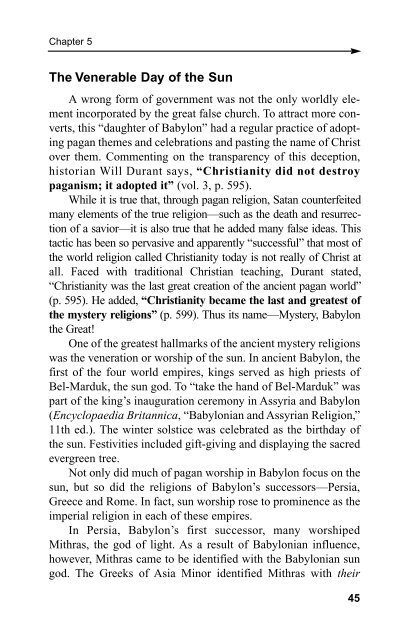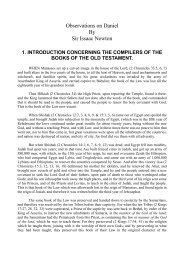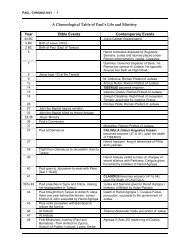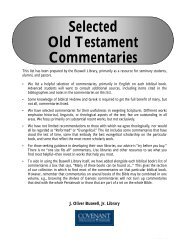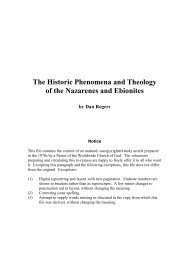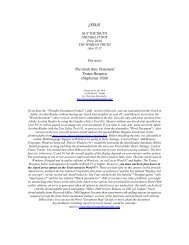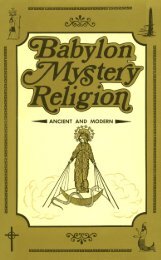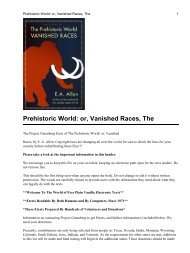Beast of Revelation.pdf - Friends of the Sabbath Australia
Beast of Revelation.pdf - Friends of the Sabbath Australia
Beast of Revelation.pdf - Friends of the Sabbath Australia
Create successful ePaper yourself
Turn your PDF publications into a flip-book with our unique Google optimized e-Paper software.
Chapter 5<br />
The Venerable Day <strong>of</strong> <strong>the</strong> Sun<br />
A wrong form <strong>of</strong> government was not <strong>the</strong> only worldly element<br />
incorporated by <strong>the</strong> great false church. To attract more converts,<br />
this “daughter <strong>of</strong> Babylon” had a regular practice <strong>of</strong> adopting<br />
pagan <strong>the</strong>mes and celebrations and pasting <strong>the</strong> name <strong>of</strong> Christ<br />
over <strong>the</strong>m. Commenting on <strong>the</strong> transparency <strong>of</strong> this deception,<br />
historian Will Durant says, “Christianity did not destroy<br />
paganism; it adopted it” (vol. 3, p. 595).<br />
While it is true that, through pagan religion, Satan counterfeited<br />
many elements <strong>of</strong> <strong>the</strong> true religion—such as <strong>the</strong> death and resurrection<br />
<strong>of</strong> a savior—it is also true that he added many false ideas. This<br />
tactic has been so pervasive and apparently “successful” that most <strong>of</strong><br />
<strong>the</strong> world religion called Christianity today is not really <strong>of</strong> Christ at<br />
all. Faced with traditional Christian teaching, Durant stated,<br />
“Christianity was <strong>the</strong> last great creation <strong>of</strong> <strong>the</strong> ancient pagan world”<br />
(p. 595). He added, “Christianity became <strong>the</strong> last and greatest <strong>of</strong><br />
<strong>the</strong> mystery religions” (p. 599). Thus its name—Mystery, Babylon<br />
<strong>the</strong> Great!<br />
One <strong>of</strong> <strong>the</strong> greatest hallmarks <strong>of</strong> <strong>the</strong> ancient mystery religions<br />
was <strong>the</strong> veneration or worship <strong>of</strong> <strong>the</strong> sun. In ancient Babylon, <strong>the</strong><br />
first <strong>of</strong> <strong>the</strong> four world empires, kings served as high priests <strong>of</strong><br />
Bel-Marduk, <strong>the</strong> sun god. To “take <strong>the</strong> hand <strong>of</strong> Bel-Marduk” was<br />
part <strong>of</strong> <strong>the</strong> king’s inauguration ceremony in Assyria and Babylon<br />
(Encyclopaedia Britannica, “Babylonian and Assyrian Religion,”<br />
11th ed.). The winter solstice was celebrated as <strong>the</strong> birthday <strong>of</strong><br />
<strong>the</strong> sun. Festivities included gift-giving and displaying <strong>the</strong> sacred<br />
evergreen tree.<br />
Not only did much <strong>of</strong> pagan worship in Babylon focus on <strong>the</strong><br />
sun, but so did <strong>the</strong> religions <strong>of</strong> Babylon’s successors—Persia,<br />
Greece and Rome. In fact, sun worship rose to prominence as <strong>the</strong><br />
imperial religion in each <strong>of</strong> <strong>the</strong>se empires.<br />
In Persia, Babylon’s first successor, many worshiped<br />
Mithras, <strong>the</strong> god <strong>of</strong> light. As a result <strong>of</strong> Babylonian influence,<br />
however, Mithras came to be identified with <strong>the</strong> Babylonian sun<br />
god. The Greeks <strong>of</strong> Asia Minor identified Mithras with <strong>the</strong>ir<br />
45


